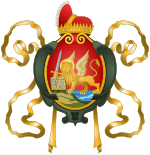Via de Zenta
The Via de Zenta (Latin for the "Senta Way"; Serbian: Зетски пут, Zetski put) was a medieval road connecting the Adriatic with Nemanjić Serbia (variously a principality, kingdom, and empire). It started from the mouth of the Bojana, the Skadar port, (alternatively Bar then Cetinje) along the Drin Valley to Prizren, then to Lipljan, then through Novo Brdo to Vranje and Niš. The Republic of Venice and Ragusa used the road for trade with Serbia and Bulgaria. From Niš continued the ancient Roman road of Via Militaris all the way to Constantinople. The road ended its use with the conquering of this part of Serbia by the Ottoman Empire (1392), the Ottomans had earlier conquered the southern provinces of Macedonia (1371), beginning their European conquest in Gallipoli (1354).
The Venetian traders, who were the most using this road, used it for export of wheat, animals, silver and grape from Serbia and Bulgaria to Italy. It was among the most important communication links of Ragusa and its hinterland. The other road connecting hinterland Serbia with the Adriatic was that from Niš, through the mining-oblasts of Kopaonik, to Via Drine. Two other [smaller] roads went through Bosnia to the northeast: one was Via Narenta, traversing the canyons of the Neretva, and the other was Via Argentaria, that connected Split with the silver mines of Ilidža and Srebrenica and in turn Sremska Mitrovica in the north.
It had an important cultural role as in connecting the hinterlands with the Adriatic cities which also had a Latin population, and Venice.
References
Sources
- Prince Stephan Lazar Eugene Lazarovich-Hrebelianovich, The Servian people:their past glory and their destiny, Vol 1, p. 298, C. Scribner's sons, 1910
- Dimitri Obolensky, Vizantijski komonvelt, pt. 13
- Francis W. Carter, Dubrovnik (Ragusa): a classic city-state, pp. 141–142, Seminar Press, 1972
